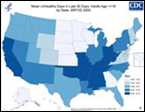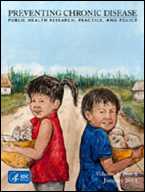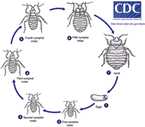December 27, 2011
Regular physical activity helps improve your overall health and fitness, and reduces your risk for many chronic diseases. Fitting regular exercise into your daily schedule may seem difficult at first, but the 2008 Physical Activity Guidelines for Americans are more flexible than ever, giving you the freedom to reach your physical activity goals through different types and amounts of activities each week. It's easier than you think! Start today and develop this habit into next year. By picking physical activities you enjoy and that match your abilities, it will help ensure that you stick with them. If you're not sure where to start, here are some examples.
»Learn more
December 23, 2011
An influenza A (H1N1) virus that is known to circulate in U.S. swine but not humans has been detected in an adult in the state of Wisconsin. The patient reported occupational contact with swine prior to illness onset. No human-to-human transmission with this virus has been identified. CDC laboratory testing has confirmed that this is a new reassortant influenza A H1N1 virus as it has acquired the matrix [M] gene from the 2009 H1N1 pandemic virus. Laboratory testing shows that the virus is susceptible to the influenza antiviral medications, oseltamivir and zanamivir. Surveillance for additional human cases in the area has been enhanced. Providers are being asked to collect specimens for influenza virus testing from any patient presenting with influenza-like illness.
»Learn more
December 19, 2011
Take steps every day to live a safe and healthy, here are a few suggestions to get you started: 1) Eat Healthy: Eat a variety of fruits, vegetables and whole grains every day. 2) Be active: Be active at least two and a half hours a week, include activities that raise your breathing and heart rates and that strengthen your muscles. 3) Protect yourself and your family: Wear helmets, seat belts, sunscreen, & insect repellent and wash hands to stop the spread of germs. 4) Manage stress: Balance work, home & play and get support from family and friends. 5) Get check-ups: Ask your doctor or nurse how you can lower your risk for health problems.
»Learn more
December 12, 2011
The Centers for Disease Control and Prevention’s (CDC) Environmental Public Health Tracking Network (Tracking Network) announces the launch of its new cutting edge mapping and data query system and the release of climate change and community design data. The Tracking Network is an online system you can use to find information on how the environment may affect your health or the health of your community. Users can sort data in many different ways, add layers to maps, and compare maps side-by-side. Learn more about the new query system here "CDC's Tracking Network: Easier, Faster, Better." Stay up-to-date on the latest Tracking Network data, conferences, podcasts, and more by requesting to join our list-serv at epht@cdc.gov.
»Learn more
December 9, 2011
CDC has confirmed two cases of human infection with two different novel influenza A viruses in different states. Both patients have fully recovered. While the viruses infecting both patients have been found in U.S. swine and some of the prior human infections with these viruses have been associated with direct or close swine contact, there are no reports of direct or close contact with swine prior to illness onset in either of these cases. Laboratory testing at CDC has confirmed that both novel viruses are susceptible to the antiviral medications oseltamivir (Tamiflu®) and zanamivir (Relenza®).
»Learn more
December 5, 2011
Bed bugs, a problem worldwide, are resurging, causing property loss, expense, and inconvenience. Bed bugs are small, flat, parasitic insects that feed solely on the blood of people and animals while they sleep. Bed bugs are reddish-brown in color, wingless, range from 1mm to 7mm (roughly the size of Lincoln’s head on a penny), and can live several months without a blood meal. The good news is that bed bugs do not transmit disease. However, the best way to treat a bite is to avoid scratching the area and apply antiseptic creams or lotions and take an antihistamine.
»Learn more
December 2, 2011
From diet books to newspaper articles, everyone seems to have an opinion about what you should be eating. It's no secret that good nutrition plays an essential role in maintaining health. While you already know it is important to eat a healthy diet, you may find it more difficult to sort through all of the information about nutrition and food choices. There are some basic concepts you can keep in mind. By knowing these basics, you will be better equipped to eat healthier. The first concept will be having an eating plan, by following a healthy eating plan will show you how much you need from each food group to stay within your calorie needs and promote good health.
»Learn more
November 28, 2011
Did you know November 6-12, 2011 is "Drowsy Driving Prevention Week"? According to the National Sleep Foundation this public awareness campaign is designed to educate young drivers (and everyone on the road!) about the dangers of driving while sleepy. While we often consider sleep to be a "passive" activity, sufficient sleep is increasingly being recognized as an essential aspect of health promotion and chronic disease prevention in the public health community. The CDC would like you to remind your readers that insufficient sleep is responsible for motor vehicle and machinery-related crashes, causing substantial injury and disability each year. In short, drowsy driving can be as dangerous-and preventable-as driving while intoxicated.
»Learn more
November 22, 2011
The Iowa Department of Public Health today reported that a “novel strain of the influenza virus has been detected in three children.” All three of the children were reportedly mildly ill and have recovered. Iowa has increased surveillance for influenza-like-illness to detect any additional cases of infection with this novel virus.
»Learn more
November 21, 2011
Although winter comes as no surprise, many of us are not ready for its arrival. Many people prefer to remain indoors in the winter, but staying inside is no guarantee of safety. Be prepared to check on family and neighbors who are especially at risk from cold weather hazards. No one can stop the onset of winter. However, if you follow these suggestions, you will be ready for it when it comes.
»Learn more
November 17, 2011
Despite everything we know about how to prevent and treat sexually transmitted diseases (STDs), they remain one of the most critical health challenges facing the nation. Today, CDC released Sexually Transmitted Disease Surveillance, 2010, its annual report on STDs in the U.S.The report provides data for the nationally reportable STDs – gonorrhea, chlamydia, and syphilis -- and shows troubling trends across all three diseases. CDC estimates, there are 19 million new infections every year, costing the U.S. health care system $17 billion annually.
»Learn more
November 14, 2011
Whether you're a seasoned chef or a novice preparing your first holiday meal, be aware of safety issues when thawing, preparing, stuffing and cooking your turkey. Food safety is especially important as you prepare a holiday meal. Within the last couple of years, CDC has investigated outbreaks of foodborne illness that were caused by bacteria in jalapeños, spinach, peanut butter, frozen pizza, frozen pot pies, and frozen beef patties. Many consumers are now more aware of the ongoing importance of food safety.
»Learn more
November 7, 2011
Diabetes is a disease in which blood glucose levels are above normal. Most of the food we eat is turned into glucose, or sugar, for our bodies to use for energy. The pancreas, an organ that lies near the stomach, makes a hormone called insulin to help glucose get into the cells of our bodies. When you have diabetes, your body either doesn't make enough insulin or can't use its own insulin as well as it should. This causes sugar to build up in your blood.
»Learn more
November 4, 2011
CDC has confirmed two additional cases of human infection with a swine–origin influenza A (H3N2) virus that carries the M gene from the 2009 H1N1 virus. The cases were reported by Maine and Indiana. There is no evidence at this time of an epidemiological link between these two patients or any person to person transmission associated with either of these cases. Both patients reported exposure to pigs prior to their illness. Human infections with swine influenza viruses are rare, but do occur. In most cases, these infections are associated with exposure to infected pigs.
»Learn more
October 21, 2011
October 21, 2011 -- CDC has confirmed the fifth case of human infection with a swine–origin influenza A (H3N2) virus that carries the M gene from the 2009 H1N1 virus. This virus was first detected in a child in Indiana in July. Subsequently three additional cases of human infection with swine–origin influenza A (H3N2) viruses carrying the same genetic change were detected in Pennsylvania. Though rare, human infections with swine-origin influenza viruses can occur, usually after close contact with infected swine. The patient in Maine was reported to have attended an agricultural fair where animals, including pigs, were present. The child was not hospitalized. He received antiviral treatment and is recovering from his illness. Though an investigation is ongoing and surveillance for influenza-like-illness is being enhanced, no human-to-human transmission of this virus has been identified in Maine.
»Learn more
September 6, 2011
September 6, 2011 -- CDC laboratory testing has confirmed two additional cases of human infection with swine origin influenza A (H3) viruses in children in Pennsylvania. These additional two cases bring the total number of confirmed cases of human infection with swine origin influenza A (H3) viruses from the Pennsylvania investigation to three. According to the Pennsylvania Department of Health, all three of the children confirmed with swine origin influenza A (H3) influenza infection reportedly attended the Washington County Agricultural Fair the week of August 13-20, 2011, where swine were exhibited. »Learn more
September 1, 2011

Recent media coverage stemming from a Food and Agriculture Organization (FAO) press release has contained misleading information about highly pathogenic avian influenza A (H5N1) viruses (“H5N1”) in Asia. Some of that media coverage has implied that there is a new, mutant variant H5N1 virus that is spreading in Asia, and that the risk to human health posed by this H5N1 virus has somehow been recently and dramatically raised. This is not true. »Learn more
July 20, 2011

CDC is collaborating with public health officials in many states to investigate an ongoing nationwide outbreak of human Salmonella Typhimurium infections associated with African dwarf frogs, a type of water frog. African dwarf frogs commonly live in habitats containing water such as aquariums or fish tanks. Download CDC's formatted article that describes the story of two mothers whose children were affected and learn how to prevent the infection. »Learn more
June 1, 2011

As the sun rises high in the sky, make sure your children are protected from the heat. Just a few serious sunburns can increase your child's risk of skin cancer later in life. Kids don't have to be at the pool, beach, or on vacation to get too much sun. Their skin needs protection from the sun's harmful ultraviolet (UV) rays whenever they're outdoors. »Learn more
May 25, 2011

Swimmers share the water—and the germs in it—with every person who enters the pool. In the past two decades, there has been a substantial increase in the number of RWI outbreaks associated with swimming. Crypto, which can stay alive for days even in well-maintained pools, has become the leading cause of swimming pool-related outbreaks of diarrheal illness. From 2004 to 2008, reported Crypto cases increased over 200% (from 3,411 cases in 2004 to 10,500 cases in 2008). »Learn more
May 19, 2011

May is Hepatitis Awareness Month, and provides an opportunity to reflect on the impact of this serious disease and the devastating consequences that can result from undiagnosed hepatitis B and C. Increased hepatitis awareness among both the public and providers is critical. Approximately four million Americans are infected with viral hepatitis and many—up to 75 percent—do not know it. Without early detection and timely care, many of those infected will develop liver cirrhosis or liver cancer. Last week, HHS released an interagency plan detailing what needs to be done to fight hepatitis in the U.S. »Learn more
May 16, 2011

How is your health? The average American says they feel unhealthy (either physically or mentally) about 6 days per month. And, about one-third of Americans say they suffer from some mental or emotional problem every month—including 10 percent who said their mental health was not good for 14 or more days a month. Having diabetes, arthritis, breast cancer, cardiovascular disease or epilepsy contributed to the amount of unhealthy days per week Americans reported. Find out how to take care of yourself at any age, with any condition, and feel healthy everyday! »Learn more
April 1, 2011

It is estimated that 19 million new STD infections occur each year in the U.S., with young people accounting for nearly half of those infections. Though most STDs can be easily diagnosed and treated, many have no noticeable symptoms, and infected individuals with STDs are at risk for serious health problems. April is STD Awareness Month, and CDC has partnered with MTV and others on the youth-oriented STD awareness and testing campaign, "GYT: Get Yourself Tested." The campaign website, GYTNow.org, shows young people how easy it is to get tested, offers tips on how to discuss STD testing with partners, parents and health care providers, and enables them to locate nearby testing centers by simply entering their zip code. »Learn more
February 2, 2011

Recently, the Robert Wood Johnson Foundation named two papers published in Preventing Chronic Disease (PCD) as being among the top five most influential research papers from their funded projects in 2010. In December, these two papers, Measuring Population Health Outcomes and Measuring the Impact of Public Health Policy, were chosen as being among the top 20 based on RWJF website popularity. Subsequently, voters from 48 states and the District of Columbia cast their ballots for the top five. PCD is a peer-reviewed electronic journal established to provide a forum for public health researchers and practitioners to share study results and practical experience. The journal is published by the National Center for Chronic Disease Prevention and Health Promotion. »Learn more
Get email updates
To receive email updates about this site, enter your email address:
Contact Us:
- Centers for Disease Control and Prevention
1600 Clifton Rd
Atlanta, GA 30333 - 800-CDC-INFO
(800-232-4636)
TTY: (888) 232-6348 - Contact CDC-INFO















